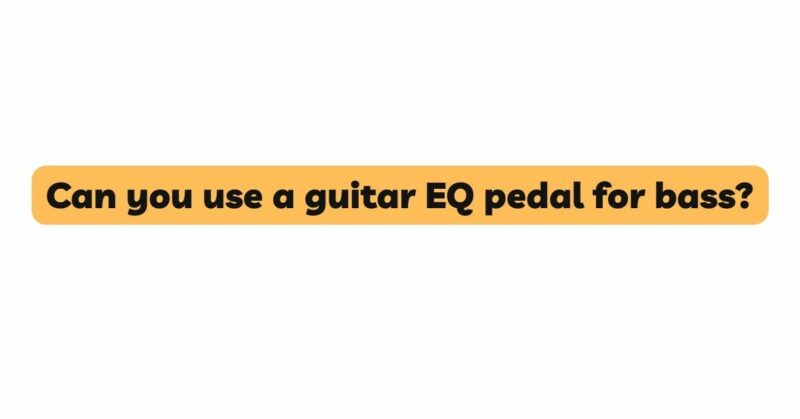Equalization (EQ) pedals are indispensable tools for musicians seeking to shape and refine their sound. Often associated with guitars, these pedals are designed to manipulate frequencies, enhancing tonal characteristics and allowing musicians to achieve their desired sonic palette. However, an intriguing question arises: can a guitar EQ pedal effectively serve the needs of bass players? In this article, we delve into the intricacies of using a guitar EQ pedal for bass, exploring its potential advantages, limitations, and the technical aspects that must be considered.
The Basics of EQ Pedals:
Before delving into the compatibility of guitar EQ pedals with bass instruments, it’s crucial to understand the fundamental workings of an EQ pedal. EQ pedals are designed to alter the balance of frequencies within an audio signal. They typically consist of multiple bands, including low, mid, and high frequencies, each equipped with adjustable controls to boost or cut specific ranges.
Guitar vs. Bass Frequencies:
One of the primary concerns when contemplating the use of a guitar EQ pedal for bass is the distinct frequency range of the two instruments. Guitars generally operate in higher frequency registers, while bass instruments cover a broader low-frequency spectrum. This discrepancy can potentially lead to limitations when applying a guitar EQ pedal to a bass signal.
Advantages of Using a Guitar EQ Pedal for Bass:
- Tonal Sculpting: Guitar EQ pedals often provide a variety of tonal shaping options that can be beneficial for bassists. The ability to cut unwanted frequencies or boost certain ranges can help bass players achieve a unique and personalized sound.
- Creative Experimentation: Utilizing a guitar EQ pedal on bass can encourage creative experimentation. By harnessing the distinct tonal characteristics of both instruments, musicians can create new textures and soundscapes that might not be achievable through conventional means.
- Cost and Convenience: For musicians who already own a guitar EQ pedal, using it for bass can be a cost-effective solution. Rather than investing in a dedicated bass EQ pedal, this approach allows for dual functionality without requiring an additional purchase.
Limitations and Considerations:
- Frequency Range: The most significant limitation of using a guitar EQ pedal for bass is the potential inadequacy of its frequency range. Bass instruments produce deeper and more robust low frequencies that might exceed the pedal’s capabilities, resulting in insufficient control over the bass’s tonal balance.
- Headroom and Signal Integrity: Bass signals can be more demanding in terms of headroom and power handling. Guitar EQ pedals may not have the necessary headroom to accommodate the bass’s signal without introducing distortion or clipping, leading to a compromised sound quality.
- Crossover Points: Dedicated bass EQ pedals often incorporate specific crossover points that align with the bass’s frequency range. A guitar EQ pedal might lack these precise crossover points, affecting the overall effectiveness of frequency manipulation.
- Wattage and Amplification: Bass amplifiers require more wattage to reproduce low frequencies accurately. Guitar EQ pedals, designed with guitar amplification in mind, might not provide the necessary wattage for a bass signal, potentially resulting in suboptimal sound output.
Optimizing the Experience:
For those determined to experiment with a guitar EQ pedal on bass, several strategies can help optimize the experience:
- Selecting the Right Pedal: Not all guitar EQ pedals are created equal. Research pedals that offer a broader frequency range and increased headroom, as these factors are crucial for bass application.
- Parallel Processing: Consider utilizing the guitar EQ pedal in conjunction with a dedicated bass EQ pedal. Running the signals in parallel allows for precise control over each instrument’s frequencies, mitigating the limitations of a single pedal.
- Amp and Cabinet Considerations: Pairing the pedal with a bass-specific amplifier and cabinet can compensate for any shortcomings in frequency handling. Bass amplifiers are designed to accommodate the instrument’s unique characteristics, enhancing the overall sound quality.
Conclusion:
The question of whether a guitar EQ pedal can effectively serve bass players is complex and multifaceted. While the concept of repurposing an existing pedal for a different instrument is enticing, it’s essential to recognize the potential limitations and compromises that may arise. With careful consideration of factors such as frequency range, headroom, and overall tonal objectives, it’s possible to leverage a guitar EQ pedal for bass in creative and innovative ways. However, for professional-grade results, investing in a dedicated bass EQ pedal remains the recommended approach, ensuring optimal control over the instrument’s distinct sonic characteristics.


